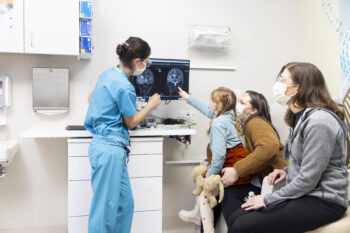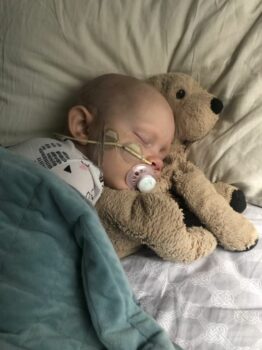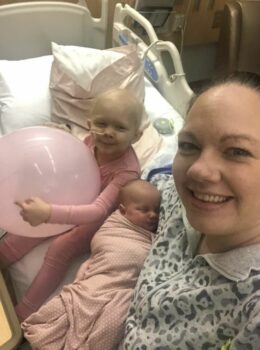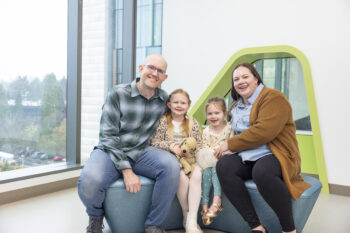 In August 2020, just after her third birthday, Aisley began to experience concerning symptoms: headaches in the back of her head, a lack of appetite and vomiting.
In August 2020, just after her third birthday, Aisley began to experience concerning symptoms: headaches in the back of her head, a lack of appetite and vomiting.
After a visit to her pediatrician, Aisley was sent to Seattle Children’s for an urgent neurology visit, where she passed the exam with “flying colors,” showing no signs of trouble.
Still, Dr. Nina Natarajan, director of the Neonatal Neurocritical Care Unit, was concerned. She’d cared for many other patients with Aisley’s symptoms and worried her energetic personality might be concealing something serious. She suggested they get an MRI of Aisley’s brain before the family drove back to their home in Marysville, Washington.
“There was something about her symptoms that didn’t sit right with me,” Dr. Natarajan recalled.
The MRI revealed Aisley had a life-threatening tumor that was pushing on the healthy parts of her brain.
“My blood drained and I couldn’t believe it,” said Cari, Aisley’s mother. “I remember looking at the doctors and asking, ‘Are you sure?’ Just that morning, Aisley had made pancakes with me and now they were telling us she had a brain tumor that might have taken her life if we’d come in days later.”
Cari and her family had been through so much already that year. Ten months earlier, Aisley’s sister, Sennett, passed away in a stillbirth.
Cari was now four-months pregnant. She’d been overjoyed as she planned for the new baby, but when she learned about Aisley’s tumor she began to wonder, “Are all of our children fated to die?”

“We make a point of setting aside time for the family to make sure we’ve answered all their questions,” said Dr. Hannah Goldstein, a pediatric neurosurgeon at Seattle Children’s. “Ultimately, they’re trusting us with their child’s life, and that is a privilege we don’t take lightly.”
Three days after she was admitted to the ICU, Aisley had a six-hour surgery to remove and biopsy her tumor.
“There were elements of the surgery that were challenging but it wasn’t outside of the range of what we see,” explained Dr. Goldstein. “We felt very good about the resection and what we were able to accomplish in the operation.”
Seattle Children’s uses advanced surgical tools that aren’t available at most care centers including innovative techniques for tumors that cannot be removed using conventional methods.
“Having a child with a brain tumor is always scary, but our surgical team knows what to do in even the most complex situations,” said Dr. Amy Lee, division chief of Neurosurgery at Seattle Children’s.
The Brain Tumor Team used genetic testing to make the most precise diagnosis possible and determined Aisley had an aggressive cancerous embryonal brain tumor. This rare type of brain cancer, most common in babies and young children, involves cells left over from fetal development.
These tumors can grow to damage healthy brain tissue and spread through cerebrospinal fluid. Just a few years before Aisley’s diagnosis, embryonal brain tumors were considered terminal, but diagnostic and treatment advances have made it possible for some patients to survive.
“When Aisley was diagnosed, our team was at the forefront of molecular testing, a technology that allows us to make a more precise diagnosis based on the genetics of a child’s tumor,” said Dr. Sarah Leary, medical director of the Brain Tumor Program at Seattle Children’s, and Aisley’s oncologist.

“A lot of tumors that were once described as universally fatal aren’t anymore because we can make a more precise diagnosis. That means more kids can be cured,” she added.
The brain tumor team has experience treating tumors like Aisley’s and had already begun developing a personalized treatment plan that would give her the best chance of surviving with as few long-term effects as possible.
Together, the team reviewed Aisley’s health records, tests, images and pathology to build the best care plan for her: six months of chemotherapy followed by six weeks of proton radiation therapy.
Seattle Children’s patients have access to the only proton therapy center in the region through the hospital’s partnership with Fred Hutchinson Cancer Center.
Proton therapy is radiation with brakes, like the brakes on a car, explained Dr. Ralph Ermoian, who saw Aisley once a week during her proton therapy.
“Imagine you’re going 60 miles an hour to get to a certain point. Once you reach that point you hit the brakes and stop shortly afterward,” he added. “That’s how protons stop after they have gone far enough to treat the tumor. The patient gets less radiation in the healthy areas of their brain, resulting in fewer or less intense long-term side effects.”

Traditional radiation affects more areas of the brain and leads to a greater risk of future tumors.
“Proton therapy is not better at treating the tumor, it’s better at protecting the other healthy parts of the brain beyond where we aim it,” said Dr. Leary. “For Aisley, the centers of her brain where language, memory and learning happen were largely spared.”
Despite enduring all of this in the middle of the COVID-19 pandemic, Aisley had an energetic, even joyful attitude throughout her treatment, recalled Dr. Ermoian. She bounced into the treatment center each day and raced him down the hallways.
Aisley made it through very intense treatments with support from many specialists on the Brain Tumor Team. Seattle Children’s has one of the largest and most comprehensive pediatric brain tumor programs in the world, with specialists who cover every aspect of care for patients like Aisley.
This includes Seattle Children’s world-renowned epilepsy specialists, who became involved in Aisley’s care when she had a seizure shortly after her brain tumor surgery. The team has since found a medication that has effectively controlled Aisley’s seizures and providers are optimistic epilepsy will not significantly affect her future.

Aisley has had no evidence of her cancer since her treatment ended in April 2021. She continues to receive exceptional follow-up care with the Seattle Children’s Brain Tumor Team.
“If Aisley had not been treated at Seattle Children’s, I don’t know if she would be here today,” said Dr. Leary. “We’re the only place in the state with the technology necessary to support a child through the intense therapy she needed to survive.”
Today, Aisley is back to doing all the things she loves, including school and competitive dance. She is also looking forward to trying activities that she was not able to do before like ice skating and swimming.
“Dr. Natarajan and the Brain Tumor Team really saved Aisley’s life that first day,” said Cari. “They could have just said, ‘She looks great’ and sent us home, but they went the extra step to get that MRI. We will always be grateful for that.”

